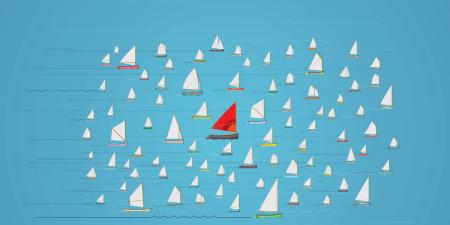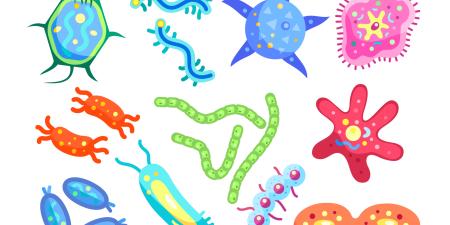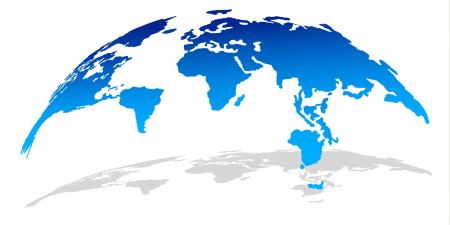Case
“Hello, this is Bob,” the doctor said as he answered his cell phone after digging it out from underneath his couch cushions.
“Bob,” the voice responded, “this is Jackson.”
“Oh, Jackson—great, this reminds me,” Bob replied while muting the volume on the football game. “Bryan's mom called this evening right after you left, and Bryan seems to have acquired another respiratory infection. I called in a refill on his antibiotics for the evening and scheduled him for you as an emergency appointment first thing tomorrow. I know with the avian flu going around the last thing you want is for one of your kids with cystic fibrosis to get pneumonia.”
There was a pause on the other end. “Yeah, well, that’s why I’m calling actually,” Jackson said. “Look Bob, I know we’ve been in practice together for a long time and it’s been great, truly it has. I mean you’re Emily’s godfather after all. The thing is, with this avian flu mess…” His voice trailed off.
“Jackson?” Bob asked, puzzled. “What are you trying to say?”
“What I’m trying to say, what I know I have to explain to you and Christine as my partners, is that I’m just not comfortable staying in the city if this is the beginning of an epidemic. Cathy and I are taking the kids to her parents tomorrow. We’re driving, staying away from the airports and everything. I’m sorry Bob, but this is looking serious. And at some point I have to start putting my own kids first. Like I said, I’ve already talked to Christine—can you 2 cover for me?”
Commentary 1
Catastrophe looms on the horizon as a spreading pandemic of virulent influenza threatens death and social pandemonium. Set against this dramatic backdrop, a physician has decided to flee with his family far from his home—and far from his medical practice and patients. In a late night telephone call, he informs his practice partner of his plans and seeks his cooperation. By vignette’s end, key themes have been placed in stark opposition: the physician’s obligations to his patients, his professional colleagues, and society more generally versus his familial duties to his wife and children or to his own health and well-being.
Identifying a Framework
Is this framework of duties, which pits different obligations against each other, an effective way to think through this case? The existentialist philosopher and novelist Albert Camus, in his masterwork The Plague, initially frames the dilemma of the physician Bernard Rieux in terms of an “abstracted” sense of professional duty: after quietly reflecting on the history of the bubonic plague and its almost incalculable implications as his city is engulfed by the epidemic, Rieux rouses himself back to action, thinking that “the thing was to do your job as it should be done” [1]. More generally, ethicists have worked hard to define physicians’ duties to patients as evidenced by the American Medical Association’s Code of Medical Ethics, which specifically proscribes physicians from abandoning their patients. In the eyes both of the law and most ethicists, once a patient-physician relationship has been established, a physician is obligated to provide subsequent care until the relationship is terminated. Furthermore, termination of this relationship can occur properly only after the physician has notified the patient and ensured that medical care will be provided through some other arrangement [2]. The AMA has extended this line of thinking to prescribe appropriate physician behavior during epidemics, arguing that, “because of their commitment to care for the sick and injured, individual physicians have an obligation to provide urgent medical care during disasters. This ethical obligation holds even in the face of greater than usual risks to their own safety, health, or life” [3].
Viewed from this established perspective, censuring the fleeing physician is easy—perhaps too easy. This is not to say that I don’t agree with the duties set forth by the AMA; I strongly believe in the obligation of physicians to remain responsibly committed to their patients and to help out when public health crises occur. Nor do I think that the vignette misrepresents the essential plot, motives, and conflict in a drama that has been replayed countless times over the centuries as innumerable physicians have fled from epidemics of plague, yellow fever, cholera, HIV, and most recently severe acute respiratory syndrome (SARS) [4-8]. No, the problem I see in analyzing this case chiefly in terms of duties is actually quite practical: such analysis is not effective in promoting better behavior because during times of crisis physicians (and many others) are likely to be more focused on understanding their personal risk rather than their professional duties. Furthermore, should an epidemic occur, the state is likely to use its authorized power to coerce needed medical personnel to perform emergency duties, and a dialogue on the nature of the duties of individual physicians misses a broader consideration of duties of the state to exercise its power fairly and effectively. These reasons for moving beyond a discussion of duties warrant elaboration.
Duties versus Risks
First, for individuals trying to decide what to do at a moment of moral crisis, the ethical definition of obligations too often provides little serious guidance for how one should behave in the face of conflicting duties. Speaking for myself, as a husband and father as well as a physician, I consider the key questions in this case to consist not of qualitative examinations of my obligations—I know these pretty well, and neither role, husband and father or physician, always trumps the other. Rather, the 2 pivotal issues in my mind are: (1) a quantitative assessment of the degree of threat to which I would be exposing my family and myself by continuing to provide care to patients (ranging between 0 and 100 percent risk of morbidity or mortality), and (2) identifying across this range my threshold of moving from "acceptable risk” into the range of "too much risk,” which is to say the point at which I would change my behavior. When would I decide to isolate myself from my family in order to protect them? When the risk of my transmitting the disease to them exceeded 1 percent, 5 percent, 10 percent? How long would I tolerate such a separation before balking? And when would the risk of my own death be sufficiently high (20 percent, 50 percent, 80 percent) that I would decide to abandon my post?
These questions are exceedingly difficult, evoking feelings of confusion, embarrassment, and almost pain in their contemplation. I know the answers would likely change under the influence of fear in the event of a real pandemic. Still, these quantitative judgments about how much I would put on the line to uphold one duty—not abandoning patients—while compromising another duty—protecting family from harm—are crucial for analyzing what physicians should and will do in such situations. Ethical analyses filled with duty-drenched language tend to stifle any forthright discussion of these judgments. To once again use myself as an example, am I displaying a disreputable disregard for a physician’s duty by pondering where on the spectrum of family and personal risk I might abandon my post? Do concerns of being judged negatively by others promote better behavior or instead prevent more honest examinations of how I might act under almost unimaginable circumstances and thereby retard more realistic preparations to act ethically?
Considerations of Power
Second, at the level of a society attempting to formulate policy to handle a full-scale pandemic, a code of physician conduct that relies only on exhortations to honor one’s duties will likely prove impotent. If the historical record teaches only one lesson, it is this: when confronted with a deadly epidemic, instead of moral persuasion, power will be what matters. Specifically, the power of the state or government operating through law and regulation is what will certainly be used to cajole or coerce unwilling physicians into compliance with official definitions of a doctor’s duties during emergencies. For example, the Model State Emergency Health Powers Act (MSEHPA), crafted by The Center for Law and the Public’s Health, and now introduced or enacted in total or in part by 44 states, proposes in section 608 that the public health authority would be empowered, “to require in-state health care providers to assist in the performance of vaccination, treatment, examination, or testing of any individual as a condition of licensure, authorization, or the ability to function as a health care provider in this State” [9-10].
Whether or not these powers would be enforced in the event of a pandemic and its aftermath remains to be seen. In previous epidemics, physicians who chose to abandon their posts or declined to care for certain patients did not appear, for the most part, to suffer punitive consequences. But, with the MSEHPA and other pieces of legislation in place, any debate about what physicians should do in the face of a public health crisis should be supplanted by a debate about what powers the state should have to compel physicians to perform certain duties and how those state powers should be put into practice. Just like a military draft, the procedure of compelling physicians to serve should be administered justly, with the burdens and dangers of providing care distributed fairly among all physicians. And, just like a military operation, there would be a heightened reciprocal duty of the state and health care institutions to do everything in their power to safeguard the well-being of the physician conscripts. This would entail preparatory planning regarding not only adequate supplies of masks, gowns, vaccines, and antivirals but also housing (for physicians who elect to quarantine themselves from their families) and staffing plans (when physicians are in short supply, due either to the excessive numbers of patients or the absenteeism of other physicians) [11].
Conclusion
In the closing lines of The Plague, as the pestilence has abated and the city is liberated from quarantine, Camus (who beyond his initial exhortation of professional duty has offered innumerable insights regarding the individual and collective experience of confronting mortal danger) observes of his hero that, “as he listened to the cries of joy rising from the town, Rieux remembered that such joy is always imperiled” [12]. In many ways the same holds true today. Given that a pandemic is regrettably all too likely, we should fortify arguments about professional duties with more concrete discussion about levels of acceptable and unacceptable personal risk and with more focused dialogue about the appropriate use of power by the state or hospitals during times of crisis.
References
-
Camus A. The Plague. 1st international ed. New York, NY: Vintage Books; 1991: 41.
-
American Medical Association. Opinion 8.115 Termination of the patient-physician relationship. Code of Medical Ethics. Available at:http://www.ama-assn.org/apps/pf_new/pf_online?f_n=browse&doc=policyfiles/HnE/E-8.115.HTM&&s_t=&st_p=&nth=1&prev_pol=policyfiles/HnE/E-7.05.HTM&nxt_pol=policyfiles/HnE/E-8.01.HTM& Accessed March 15, 2006.
-
American Medical Association. Opinion 9.067 Physician obligation in disaster preparedness and response. Code of Medical Ethics.Available at: http://www.ama-assn.org/apps/pf_new/pf_online?f_n=browse&doc=policyfiles/HnE/E-9.067.HTM&&s_t=&st_p=&nth=1&prev_pol=policyfiles/HnE/E-8.21.HTM&nxt_pol=policyfiles/HnE/E-9.01.HTM& Accessed March 2, 2006. See also American Medical Association. Opinion 10.01 Fundamental elements of the patient-physician relationship. Available at: http://www.ama-assn.org/apps/pf_new/pf_online?f_n=browse&doc=policyfiles/HnE/E-10.01.HTM&&s_t=&st_p=&nth=1&prev_pol=policyfiles/HnE/E-9.132.HTM&nxt_pol=policyfiles/HnE/E-10.01.HTM& Accessed March 15, 2006.
-
Emanuel EJ. Do physicians have an obligation to treat patients with AIDS? N Engl J Med. 1988;318(25):1686-1690.
- Freedman B. Health professions, codes, and the right to refuse HIV-infectious patients. Hastings Cent Rep. 1988;18(2):S20-S25.
- Masur H, Emanuel E, Lane HC. Severe acute respiratory syndrome: providing care in the face of uncertainty. JAMA. 2003;289(21):2861-2863.
-
Powell JH. Bring Out Your Dead: The Great Plague of Yellow Fever in Philadelphia in 1793. Philadelphia: University of Pennsylvania Press; 1993.
-
Rosenberg CE. The Cholera Years: the United States in 1832, 1849, and 1866. Chicago, Ill: University of Chicago Press; 1987.
- Gostin LO, Sapsin JW, Teret SP, et al. The Model State Emergency Health Powers Act: planning for and response to bioterrorism and naturally occurring infectious diseases. JAMA. 2002;288(5):622-628.
-
The Center for Law and the Public’s Health at Georgetown and Johns Hopkins Universities. Model State Public Health Laws. Available at: http://www.publichealthlaw.net/Resources/Modellaws.htm#MSEHPA. Accessed February 27, 2006.
- Kotalik J. Preparing for an influenza pandemic: ethical issues. Bioethics. 2005;19(4):422-431.
-
Camus, The Plague, 308.



